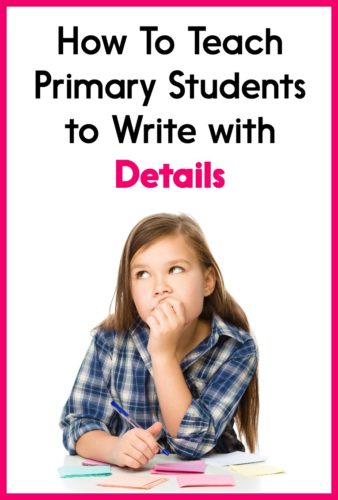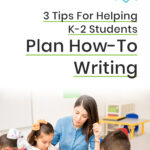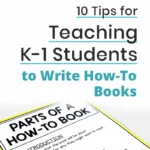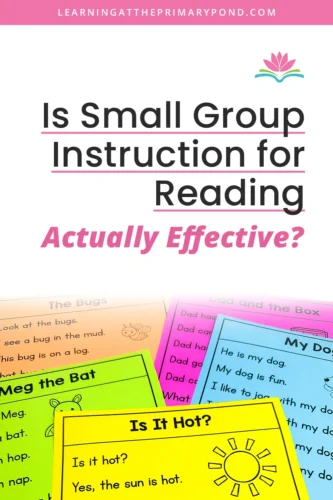Sometimes I have a hard time getting students to write with details. Can you relate?
For example, a child might make a statement and then repeat it in different ways: “I like baseball. Baseball is fun. I have fun when I play baseball. I love baseball.”
Their writing may look “long,” but it’s repetitive rather than detailed. And that type of writing drives me a little bit crazy!
The good news is that there are steps we can take to get our kids to write with more QUALITY details. During the month of May, I’ll share a series of posts with strategies that have worked for me.
Today’s post will give some general tips for all genres, but make sure to check back each Saturday for more specific tips and lots of freebies to help get your students writing with more detail!

Photo Credit: Serhiy Kobyabov, Shutterstock
Getting Specific With Our Expectations
The problem is, when we say, “Add more details!” to our students, they don’t always know what we mean. So we need to be more detailed in our requests for more detail! 🙂
I like to plan specific lessons during each unit that are designed to help students write with more detail. For example, during a nonfiction unit, I might include the following two lessons:
- Add more detail by giving specific examples
- Add more detail by using adjectives to describe
In each lesson, I model how I add more details using this strategy, have the kids help me add more details to a real piece I’ve written, and then ask the kids to try out the strategy in their own writing.
I’ve found that it’s so much clearer for my students when I say, “Try using an adjective to describe the elephant’s trunk or ears” instead of just “Add more details, please!”
During the next three weeks, I’ll share the specific “detail focused” lessons that I teach for nonfiction, fiction, and opinion writing. There will be free lessons for you to download and use right away!
Using Mentor Texts
Published children’s books are a great resources for teaching kids about including detail in their writing. Before you closely examine a text with students, make sure you’ve read it aloud to them recently (so that they can focus on comprehending it during the first read).
Toward the beginning of a unit, you can use a mentor text to model how you notice the details included by the author.
For example, you might say, “On this page, I noticed that the author gave specific examples of different types of amphibians. Let me show you what I mean.” (And then read aloud the page and point out the specific examples.)
Then, you might model for students how you add specific examples to your own writing. Students could then take out a finished or nearly-finished nonfiction piece of their own and add in some specific examples.
Later on in a unit, you might help the class come up with different categories of details (i.e. labels on the pictures, specific examples, adjectives, vivid verbs). Then, the class can comb through a couple of pages of a mentor text, looking for places where the author included these types of details.
Short articles are another great way to get kids involved with finding details in texts. ReadWorks.org has lots of free, simple articles and stories that even first graders or advanced Kindergarteners can read.
To use one of these articles, read it aloud to the class first. Then, pass out copies and have students highlight or underline places where the author included details.
Help students connect this activity to actual writing by having them try out something the author did in their own writing. For example, if they noticed that an author described the setting, they can add a setting description to their own stories.
Holding Kids Accountable
If you ask one of your students if she included lots of details in her writing, you might get a “yes.” But does she really know if she did or not?
Having kids go back to their own writing and point out specific examples of details is a great way to hold them accountable when they’re finished with a piece. You can make a photocopy of a child’s writing and have them highlight or underline specific details on the photocopy. Students can then use a rubric to rate their own use of details.
Another option is to have students get help from a partner. One child reads her writing aloud to another student, and then the other student highlights or underlines the details. The students then switch roles.
Not only does this give students a fresh perspective on their own writing, but it also provides an opportunity for students to learn about writing with details from their peers’ work.
Update
I now have three additional posts that go even more in depth on teaching students to write with details! 🙂 Check them out here:
- Nonfiction Writing with Details (Read it HERE)
- Fiction Writing with Details (Read it HERE)
- Opinion/Persuasive Writing with Details (Read it HERE)
I also have some “writing with details” freebies that you can download by filling in your information here:
Success! Now check your email to download the freebie.
Happy teaching!













Great article, so informative. I will be starting my student teaching in the fall. Thanks for sharing!!!
Thanks Tiffany! So glad it’s helpful. Good luck with your student teaching! 🙂
Alison
Getting Kinders to write with details is a never ending job…Thank you for some insight/ideas as how to help them learn to do so.
So true, Chelle! Thanks for reading! 🙂
Alison
I can’t get the videos to save
Hi Lori! If you click on the videos, they should play. You can just save the whole post if you want to return to it. 🙂
Alison